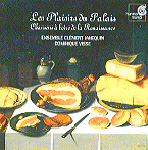Forget the disc’s subtitle–“drinking songs of the Renaissance”–put away the liner-note translations, sit back, and just enjoy this thoroughly entertaining collection of what in reality are secular songs from 16th century France and the Netherlands. Although a few are specifically about drinking, most of the texts (some rather coarsely and graphically) describe other aspects of daily life–the delights and despair of love, the hunt, and food. But it’s the musical effect of these pieces, written by several of the period’s most celebrated masters and primarily scored for multiple voices, that immediately captures our attention–not the subject matter or particulars of the texts. In fact, the performers’ programmatic intention here is to show both the similarities and distinctiveness of the traditional Flemish and French chanson styles, from the intricate, often expansive polyphony of the former to the more straightforward, text-conscious homophony of the latter.
Whether or not you choose to notice these details, you certainly will notice the extraordinary vibrancy of the sonorities–not only a function of the writing, but largely due to this male-voice ensemble’s ideal mix of vocal timbres, perfect intonation, and interpretive uniformity. You’ll also notice some rather startling vocal “sound effects” that are essential to illustrating several of the texts–animal noises in Nicolas Gombert’s “La chasse au lievre” (The hunt of the hare), and rather desperate-sounding yet increasingly hilarious human cries in Dambert’s “Secouez moy”. The sad love songs by Certon and Sermisy are heartbreakingly lovely, as is Clemens non Papa’s “prayer”, Priere avant le repas, that opens the disc. The anonymous Triquedon daine is in the best tradition of bawdy tavern songs, and Eric Bellocq’s phenomenal solo lute and guitar work alone would be worth the price of the disc if there were just a little more of it. The settings of the songs vary in number of singers (from solo to five) and from a cappella to accompanied–by viols, plucked strings, and organ. The sound, from a Parisian church, is as immediate, full-bodied, detailed, and natural as it gets–in a word, reference quality, and so are the performances.
































